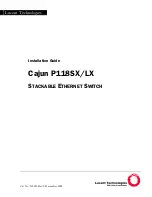
NEXPEED NBG440 User’s Manual
NexComm Systems, Inc. 87 PAGE
Configuring RIP
The NBG440 router supports RIP1 and RIP2 to configuring the dynamic route.
The Routing Information Protocol (RIP) is one of the most popular protocols currently in use.
It is a classical distance-vector routing protocol. RIP is documented in RFC 1058.
RIP uses broadcast User Datagram Protocol (UDP) data packets to exchange routing information.
RIP sends routing information updates every 30 seconds; this process is termed advertising. If a
router does not receive an update from another router for 180 seconds or more, it marks the routes
served by the nonupdating router as being unusable. If there is still no update after 240 seconds,
the router removes all routing table entries for the nonupdating router.
The metric that RIP uses to rate the value of different routes is hop count. The hop count is the
number of routers that can be traversed in a route. A directly connected network has a metric of
zero; an unreachable network has a metric of 16.
RIP1(version I) does not support the subnet mask information, whereas RIP2 (version II) supports
CIDR (Classless Inter-domain Route) block address, VLSM (Variable Length Subnet Masking),
route summarization, and authentication.
Related Commands :
rip enable / rip disable / rip send / show rip
Enable or Disable RIP
You can configure the router to send and receive RIP updates, respectively, to and from
the remote router. The default is to not send or receive RIP updates. If you don’t enable
a RIP routing process, you must configure static routes for the routed networks using
the
ip route add
command.
















































